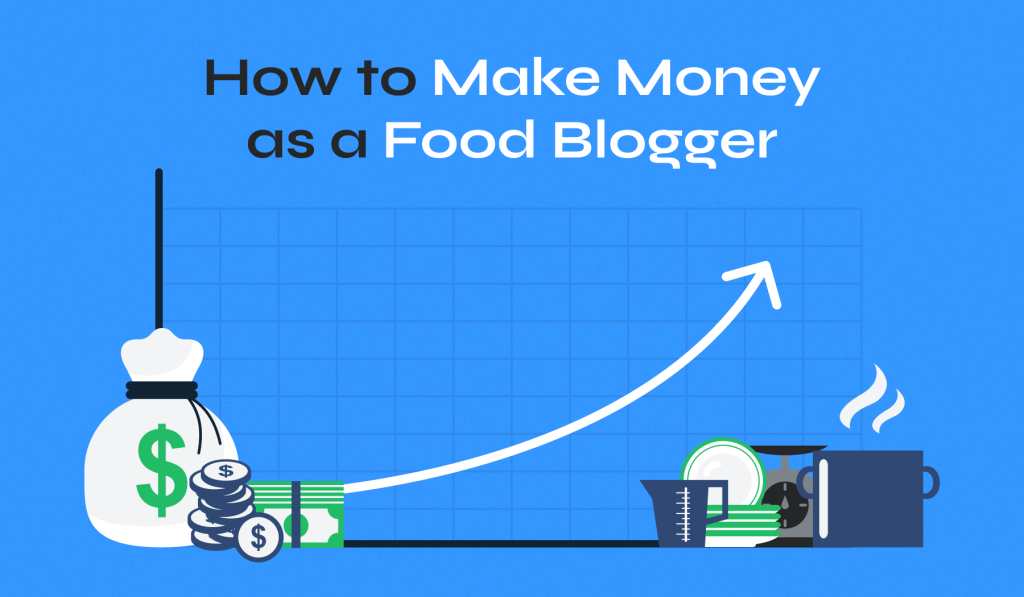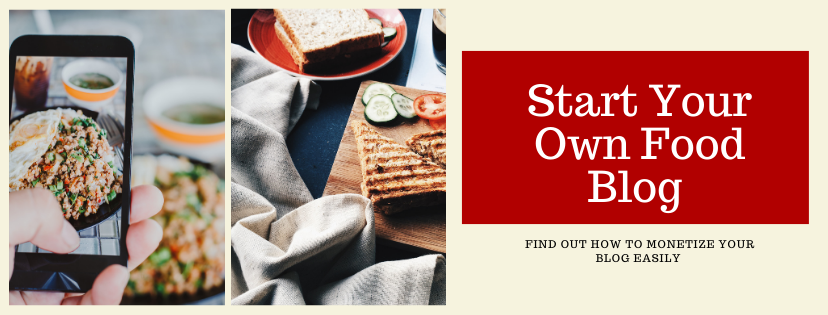Hungry for more than just like? You’ve built a food blog packed with delectable dishes and a dedicated following. Now, let’s turn up the heat and explore creative ways to monetize your foodie passion. From tried-and-true ad placements to sizzling product sales, this post is your recipe for success. Get ready to watch your income rise like a perfectly golden souffle!
Tired of Ads? Explore Delicious Revenue Streams for Your Food Blog!
- While display ads can be a starting point, many food bloggers crave more flavorful ways to monetize their passion.
- The good news is, there’s a whole options out there!
Ditch the Banner, Embrace the Brand Partnership:
- Food brands are always looking for creative partners.
- Partner with them to create sponsored content featuring their products.
- Think of recipe development using their ingredients, beautiful product photography, or even hosting cooking demonstrations or contests.
- Remember, transparency is key! Disclose sponsored content clearly and ensure brand collaborations align with your blog’s voice.
Become an Affiliate Marketing Maestro:
- Love a particular spice blend or a handy kitchen gadget?
- Recommend them to your audience through affiliate links!
- When someone clicks your link and makes a purchase, you earn a commission.
- But remember, quality is key.
- Only recommend products you genuinely love and use, fostering trust with your readers.
From Blog Post to Bestseller: The Power of eBooks and Courses:
- Turn your blog’s magic into valuable resources!
- Compile your recipes into a downloadable ebook or a stunning physical cookbook.
- Alternatively, create online cooking courses where you share your culinary wisdom in greater depth.
- These options allow you to directly sell your expertise and provide even more value to your audience.
Thinking Outside the Recipe Box: Selling Your Products:
- Have a signature hot sauce recipe or a unique line of handmade cooking tools?
- Consider selling your products alongside your recipes.
- This allows you to build a brand identity beyond the blog and cater directly to your audience’s needs.
The Art of the Digital Feast: Paid Memberships and Exclusive Content:
- Offer exclusive content like premium recipes, downloadable meal plans, or in-depth cooking tutorials through a paid membership program.
- This allows dedicated followers to access a deeper level of engagement and support your blog financially.
- Remember, the key to success is diversification.
- Don’t rely on a single source of income.
- Experiment with different strategies to find a delicious mix that works for you and your audience.

Is Affiliate Marketing the Secret Ingredient for Your Food Blog?
- You spend hours crafting mouthwatering recipes, perfecting food photography, and building a community of passionate food lovers.
- But let’s be honest, bloggers gotta eat too (and ideally, not just ramen noodles)!
- While display ads can provide a base income, many food bloggers crave more flavorful ways to monetize their passion.
Enter affiliate marketing: a potential secret ingredient for transforming your blog into a financially rewarding business.
What is Affiliate Marketing?
- Imagine you rave about a particular brand of olive oil that elevates every dish.
- With affiliate marketing, you can include a special link to that olive oil in your recipe post.
- When someone clicks your link and makes a purchase, you earn a commission.
- It’s a win-win! You recommend products you love, and your readers discover culinary gems, while you get rewarded for the valuable connection.
Why Consider Affiliate Marketing?
- Here’s the beauty: affiliate marketing allows you to monetize your existing content.
- Do you already write glowing reviews about your favorite kitchen tools?
- Perfect! Include affiliate links for those products.
- Sharing meal plans that feature specific ingredients?
- Look for opportunities to partner with those brands.
The Key Ingredient: Authenticity
- However, building trust with your audience is paramount.
- Don’t just shove affiliate links everywhere!
- Carefully choose products that genuinely align with your recipes and cooking style.
- Readers can sniff out inauthenticity a mile away.
- Focus on recommending products you truly believe in, and your audience will appreciate your honesty.
Is Affiliate Marketing the Secret Weapon?
- Affiliate marketing can be a powerful tool, but it’s not a magic solution.
- It takes time and effort to build a loyal audience and establish yourself as a trusted source.
- However, by strategically incorporating affiliate links and focusing on authenticity, you can turn your foodie finds into financial rewards.
- So, experiment, have fun, and see if affiliate marketing adds the right flavor to your recipe for success!
What are the Sponsored Posts and Brand Deals?
- Imagine collaborating with your favorite organic produce company to develop a series of seasonal recipes featuring their ingredients.
- Or, a renowned cookware brand approaches you to create a sponsored post showcasing their latest product line.
- These are just a few examples of how sponsored content and brand deals can work.
The Recipe for Success:
1. Know Your Worth: Before diving in, understand your blog’s value. Consider factors like audience size, engagement levels, and niche focus. This will help you negotiate fair compensation.
2. Partnerships with Purpose: Don’t sell out! Align yourself with brands that resonate with your blog’s identity and your audience’s interests. Authenticity is key! Promote products you genuinely believe in to maintain reader trust.
3. Creative Collaboration: Sponsored content shouldn’t feel like a forced advertisement. Work with brands to develop engaging content that seamlessly integrates their product into your unique voice. Think of recipe development using their ingredients, beautiful product photography demonstrations, or even hosting cooking contests.
4. Transparency is Key: Disclose any sponsored content. Building trust with your audience is vital. Be upfront about brand partnerships and highlight the value proposition for both you and your readers.
The Sweet Rewards:
- Sponsored content and brand deals can offer a significant financial boost to your blog.
- But the benefits go beyond just the paycheck.
- These partnerships can expand your reach, expose you to new audiences, and even lead to long-term collaborations.
- So, if you’re ready to take your food blog to the next level, consider exploring sponsored content and brand deals.
- Remember, careful brand selection, creative collaboration, and transparency are essential ingredients for a successful partnership.
- With the right approach, you can transform your blog into a thriving culinary business and forge delicious connections along the way.


Can Ebooks, Cookbooks, and Courses Unlock Your Food Blogging Expertise?
- Your blog is a haven for delicious recipes, stunning visuals, and a community of passionate food lovers.
- But have you ever considered taking your expertise beyond the blog post?
- Ebooks, cookbooks, and online courses offer exciting avenues to unlock your food blogging knowledge and create a thriving knowledge base.
From Blog to Book:
- Imagine transforming your most popular recipes into a downloadable ebook or a beautifully designed physical cookbook.
- This allows you to curate your content and offer a comprehensive resource to your audience.
- Think-themed collections, budget-friendly meal plans, or even specialized recipe guides for dietary needs.
- The possibilities are endless!
The Allure of Online Courses:
- Beyond static content, online courses allow you to share your culinary wisdom more interactively.
- Create video tutorials demonstrating cooking techniques, host live Q&A sessions on specific cuisines, or offer in-depth modules on food photography and styling.
- This format caters to learners who crave personalized instruction and deeper engagement.
Unlocking the Benefits:
1. Passive Income Powerhouse: Ebooks, cookbooks, and online courses can generate passive income, a steady stream of revenue without the constant need for content creation. Once developed, these products can continue to sell and earn you money while you focus on other aspects of your food blogging journey.
2. Expand Your Reach: These resources can attract a wider audience beyond your blog’s regular visitors.
3. Establish Authority: Developing these in-depth resources positions you as a trusted authority in the food blogging world.
Is it Right for You?
While ebooks, cookbooks, and courses offer fantastic opportunities, they do require an investment of time and effort. Carefully consider your content strategy, target audience, and the time commitment involved before diving in.
The Delicious Takeaway:
- Ebooks, cookbooks, and online courses can be powerful tools to monetize your food blogging expertise and connect with your audience on a deeper level.
- So, if you’re ready to expand your reach, generate passive income, and solidify your culinary authority, consider venturing beyond the blog post and explore these exciting options.
- Remember, the world is hungry for your unique knowledge, so go forth and share your culinary wisdom!

How to Sell Your Products?
- You’ve poured your heart and creativity into crafting a unique product, be it a mouthwatering spice blend or a revolutionary kitchen gadget.
- But now comes the crucial question: how do you turn that product into a thriving business?
- Fear not, aspiring entrepreneur!
- This guide will equip you with the knowledge to navigate the exciting world of selling your creations.
1. Know Your Market:
- Before diving headfirst, conduct thorough market research.
- Identify your target audience, understand their needs and pain points, and research any existing competitors.
- This knowledge will inform your product positioning, pricing strategy, and overall marketing approach.
2. Craft a Compelling Brand Story:
- In today’s crowded marketplace, a strong brand story is essential.
- What makes your product special?
- How does it solve a problem or elevate the user experience?
- Craft a narrative that resonates with your target audience and connects them to your brand on an emotional level.
3. Build an Online Presence:
- E-commerce is king. Create a user-friendly website showcasing your product’s features and benefits through high-quality images and engaging descriptions.
- Utilize social media platforms like Instagram and Facebook to build brand awareness and connect with potential customers.
4. Embrace the Power of Content Marketing:
- Don’t just sell, educate and inspire.
- Create valuable content related to your product’s use.
- Think recipe tutorials if it’s a spice blend, or kitchen organization tips if it’s a storage solution.
- This establishes you as an authority and subtly positions your product as the answer to their needs.
5. Explore Multiple Sales Channels:
- While an online presence is crucial, don’t limit yourself.
- Consider selling your product at local farmers markets, craft fairs, or specialty stores that cater to your target audience.
- This allows for in-person interaction and the opportunity to directly connect with potential customers.
6. Leverage the Power of Reviews and Testimonials:
- Positive customer feedback is gold!
- Encourage satisfied customers to leave online reviews and testimonials.
- Social proof builds trust and encourages others to take the leap and purchase your product.
7. Embrace Feedback and Adapt:
- Selling your product is a continuous learning process.
- Be open to customer feedback and use it to refine your product or marketing strategy.
- Stay up-to-date on industry trends and adapt accordingly to ensure your product remains relevant and competitive.
The Takeaway:
- Selling your product is a rewarding journey, but it requires dedication and a strategic approach.
- By understanding your market, crafting a compelling brand story, and utilizing the power of online marketing and customer engagement, you can turn your unique creation into a thriving business.
- Remember, success doesn’t happen overnight, so be patient, adapt, and keep that entrepreneurial spirit alive!
